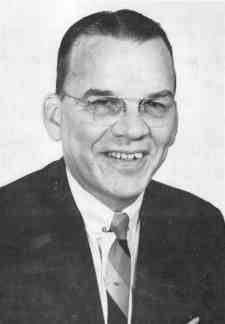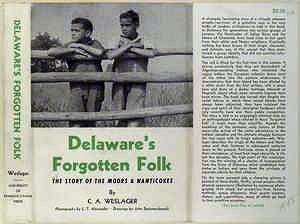Collecting Delaware Books
C. A. Weslager 1909-1994
Contents
One of Delaware's most popular and collectible authors, C.A. Weslager died in 1994. Though interest in his books has decined slightly since his death, they are still sought after. A complete set of Weslagers signed and in dust jackets is still a desireable and difficult goal. Here is material from two articles in Collecting Delaware Books.
Tribute written August 1994

The Delaware book community is saddened by the death of writer and historian C. A. Weslager on August 5. During half a century he wrote more than fifteen books and hundreds of pamphlets and articles about our state.
Clinton Alfred Weslager was born April 30, 1909, in Pittsburgh, the son of Alice (Lowe) and Fred Weslager. Fred Weslager was a building contractor. Clinton received a bachelor of arts degree from the University of Pittsburgh, then followed a special studies course at the University of Delaware.
From 1928 to 1933 he was a feature writer for a number of publications. In 1933 he joined the Life Savers Corporation in Port Chester, New York, writing sales literature and editing the company magazine. In 1937 he joined the Du Pont Company as a writer, editor, and sales executive and remained there until retirement.
In 1943 he began to publish books about Delaware's past. These books appeared regularly over the years, and his output barely slackened as he reached his seventies and eighties.
The books were always carefully researched and cleanly written. He had a knack for picking out the parts of the story that interested people. Readers display an astonishing affection for his books. Perhaps his most-loved book was Delaware's Forgotten River. I have had people return to my shop to say how much they enjoyed it.
If ever a person was born to write, it was C. A. Weslager. Right up to his death he was bubbling with enthusiasm for his writing projects. He called me in July to tell about all the wonderful things he had discovered to put in an article for Collecting Delaware Books. The article was to be about an informal group formed several decades ago at the University of Delaware to promote interest in Delaware history. Little did I know he was working on articles for other publications, too.
Last November Weslager helped plan a signing party for the reissue of his Brandywine Springs. He and his wife Ruth spent two hours meeting his admirers. Though looking frail and complaining of poor health, he signed several hundred books that day and chatted with each visitor. He clearly enjoyed the adulation.
C. A. Weslager is the last of a generation of journalist-historians that also included Bill Frank and W. Emerson Wilson. He leaves us a tangible legacy of wonderful Delaware books that will be read, collected, and cherished for years to come. — John P Reid, Editor, Collecting Delaware Books
C. A. Weslager Signing Party
This article was published in 1993.
The signing party for advanced subscribers to the new printing of C. A. Weslager's Brandywine Springs the Rise and Fall of a Delaware Resort was held at the shop of John P. Reid, 307 Main Street, Stanton on Saturday, November 20. Dr. Weslager and his wife greeted visitors from 2:00 to 4:00 p.m.
The new printing includes 250 hardbound copies and a larger number of paperbound. The first six hardbound copies were reserved for the author. Copies numbered up to 49 were signed at the party. In addition, Dr. Weslager signed 135 other books by him brought by visitors.
A special feature of the day was a display of books representing 50 years of publication by Dr. Weslager. It was set up by Rowland Hearn. Most were in fine condition, signed by the author, and in dust jackets. Although several collectors have similar complete collections, this one was most impressive.
His Books
In late 1991, we asked C. A. Weslager for a list of his books to be printed in the first issue of Collecting Delaware Books, published in February 1992. The following is that list, annotated in 2004 to reflect collectibility and current interest. The list does not include his hundreds of article and leaflets. Many of his books were published in multiple printings, including added paperback editions. These are not always distinguished here. Note that Weslager's first name was Clinton, however he never allowed it to be used on his writings. It was always "C. A."

- Delaware's Forgotten Folk. 1943. Univ. of Pa. Press, Philadelphia. Reissue in 2006.
- Wynicaco, a Choptank Indian Chief. 1944. American Philosophical Society. A reprint from the Proceedings of the American Philosophical Society, vol. 87 no. 5, 1944. — New listing 2006
- Delaware's Buried Past. 1944. Univ. of Pa. Press, Philadelphia. Reissued in paperback in 1966 by Rutgers Univ. Press, New Brunswick, NJ with an addendun pp171-205.
- Delaware's Forgotten River. 1947. Hambleton Co., Wilmington, DE. This is perhaps his most-loved book.
- The Nanticoke Indians. 1948. Pa. Historical Commission, Harrisburg, PA.
- Brandywine Springs. 1949. Hambleton Co., Wilmington, DE. A continued seller because of the preservation activities surrounding the site of the Brandywine Springs resort.
- Indian Place-Names in Delaware with Dr. A.R. Dunlap. 1950. Archaeological Society of Del., Wilmington DE.
- A Brief Account of the Indians of Delaware. 1953. Univ. of Del. Press, Newark, DE. A 31-page pamphlet. Reprinted 1963. Revised and reprinted 1973.
- Red Men on the Brandywine. 1953. Hambleton, Wilmington, DE. Reprinted and updated with an addendun pp. 142-151 in paperback 1976 by Delmar News Agency.
- The Richardsons of Delaware. 1957. Knebels Press, Wilmington, DE. This is the most valuable Weslager book. See the separate article below.
- A Brief Account of the Richardson School. 1959. Richardson Park Board of School Trustees, Wilmington, DE. A 31-page pamphlet issued in large quantity.
- 140 Years Along Old Public Road. 1960. Historic Red Clay Valley, Inc., Wilminton, DE. A 38-page pamphlet.
- Dutch Explorers, Traders, and Settlers in the Delaware Valley. 1961. Univ. of Pa. Press, Philadelphia, PA.
- The Old Hollingsworth Plantation. 1961. Historic red Clay valley, Inc., Wilmington, DE. A 33-page pamphlet.
- The Accomac and Accohannock Indians from Early Relations. 1961. Eastern Shore of Va. Hist. Soc. [Onancock, VA]. A 29-page pamphlet.
- August Weslager and His Family of Pittsburgh, Pa. 1964. Privately printed. A 39-page pamphlet.
- The Garrett Snuff Fortune. 1965. Knebels Press, Wilmington, DE. This book takes fluctuations in value. It tells of legal proceedings of family members attempting to claim a large fortune made by a Delaware relative. Although the courts have long ago settled the matter, periodically a new generation of the family rediscovers the case and begins buying copies of the book, hoping to renew the claim.
- The English on the Delaware. 1967. Rutgers Univ. Press, New Brunswick, NJ.
- The Log Cabin in America. 1969. Rutgers Univ. Press. New Brunswick. NJ.
- A History of the Armstrong Lodge No. 26, Newport, Del. 1970. Published by the lodge and printed by Wm. E. Cann, Inc., Wilmington, DE.
- Notes About the Families of William Lowe and Eliza (Perry) Lowe of Pittsburgh, Pa. 1971. Privately printed, Wilmington, DE.
- The Delaware Indians, A History. 1972. Rutgers Univ. Press, New Brunswick, NJ. Slightly revised and reissued in paperback 1989. Second paperback printing in 1991 with revised back cover.
- Magic Medicine of the Indians. 1973. Middle Atlantic Press, Wallingford, PA. Revised in paperback in 1974 by Signet, New American Library, New York, NY.
- The Stamp act Congress. 1976. Univ. of De. Press, Newark, DE.
- The Delawares, A Critical Bibliography. 1978. Indiana Univ. Press, Bllomfield, IN.
- The Delaware Indian Westward Migration. 1978. Middle Atlantic Press, Wallingford, PA.
- The Nanticoke Indians, Past and Present. 1983. University of De. Press, Newark, DE.
- The Swedes and the Dutch and New-Castle. 1987. Middle Atlantic Press Wilmington, DE. Paperback and hardback.
- New Sweden on the Delaware. 1988. Middle Atlantic Press Wilmington, DE. Paperback and hardback.
- A Man and His Ship. 1989. Kalmar Nyckel Foundation, Wilmington, DE. Paperback and 1,000 hardbacks.
Most Valuable Weslager Book?
This article appeared in 1995.
Prices for books by C. A. Weslager have remained steady or even declined slightly since his death. However, prices for his The Richardsons of Delaware are always high. A nice copy with an intact dust jacket and the loose map can bring at least $200.
The Richardsons of Delaware was published in 1957 at The Knebels Press, Wilmington, in an edition limited to 500 copies and has never been reprinted. It was Weslager's seventh book.
The book tells the story of John Richardson, who came to New Castle County before 1687, and his descendants into the 20th century. In so doing, it also provides a vivid history of the area around Maryland Avenue and Dupont Road (Delaware 4 and 100). This includes Richardson Park, Glynrich, Ashley, and Elmhurst, subdivided in 1904, 1905, 1908, and 1918 respectively on land once owned by the Richardsons.
Route 4 from the Wilmington border to Stanton has hundreds of early homes still standing. One of the finest of these is Ashley, located at "Five Points," the intersection of Maryland Avenue and Dupont Road. It was the home of generations of Richardsons and is now a tastefully restored office building.
On May 31, 1854, a tremendous explosion was felt at Ashley. Hannah Richardson wrote, "The concussion even here was frightful. Ashton, who was in the backyard talking to Mary, cringed or rather stooped — feeling as though something was falling on his head, altho like me who was indoors he was more possessed of the idea of an earthquake than anything else. We ran to look, however, in the direction of the two [Dupont] Powder Mills...."
As it turned out, two Dupont wagons carrying 5 tons of black powder to the docks in Wilmington had exploded on 14th Street opposite Bishopstead, the residence of Episcopal Bishop Alfred Lee. Hannah's sister lived in that area, and her home lost 54 panes of glass. Other homes were destroyed, and a number of people were killed. (Though not directly related to the Richardson Park area, Weslager includes four Richardson family letters about the explosion in the appendix.)
Wilmington forbade the transportation of black powder through the city. The Dupont Company laid out one road to wharfs at Edgemoor on the Delaware. A second route, Dupont Road, brought additional powder shipments to a wharf on the Christina only few blocks from Ashley.
As a young woman, Hannah Richardson was a founding member of the Ladies Botanical Society of Wilmington. She maintained an 18-year correspondence with Dr. William Darlington, a leading botanist of the day. Both sides of this correspondence have been preserved, and the bound letters are held by Society of Natural History of Delaware.
The Weslager book includes 29 photographs and 9 drawings by Walter Stewart. One of the drawings is a tracing of a 1683 map of the area, inserted as a loose sheet. It is 8.5" by 17," folded in half on the long axis, then folded in thirds the other way. Examined under a strong magnifying glass, the paper shows some rag content. This map is usually less yellowed than the pages of the book. Collectors should be alert to the possibility of this sheet having being reproduced in a copier to replace a missing one.
The Richardsons of Delaware is well written and documented. It is useful to both the genealogist and the historian. Its greatest appeal is to those who live in the Richardson Park area, but it has become one of the key books of Delaware book collecting.